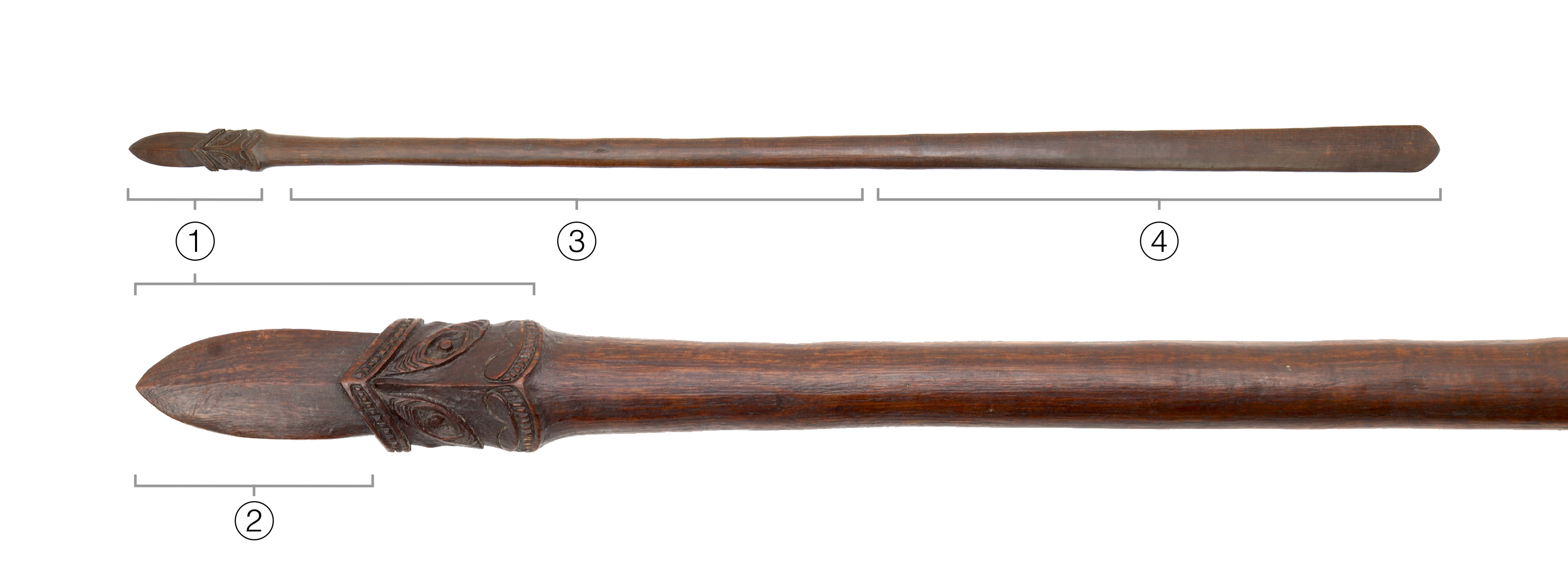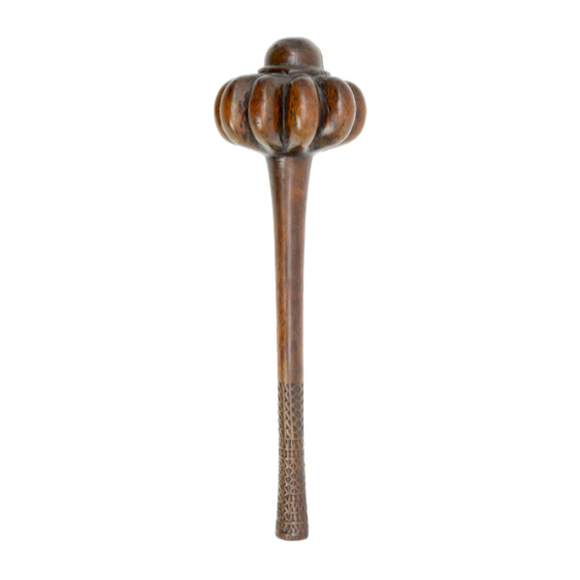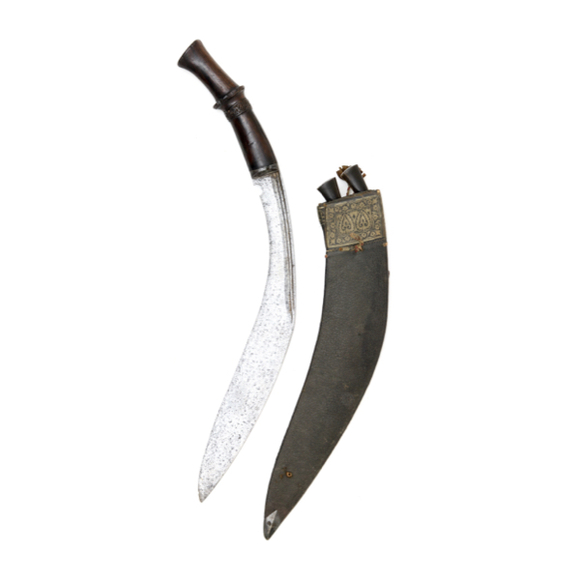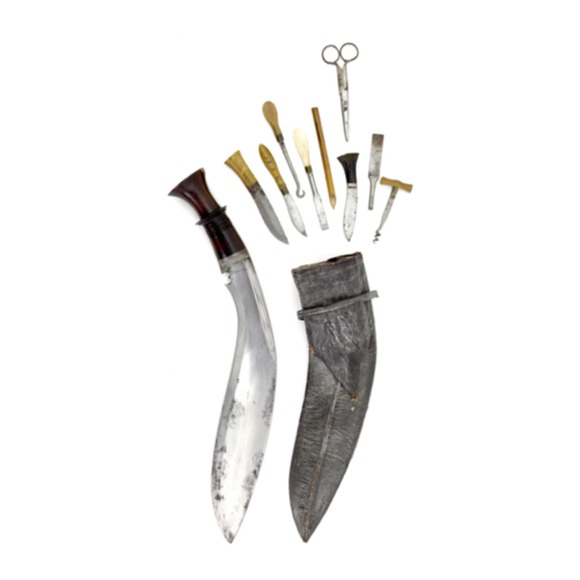Language: Maori / Taranaki
Origin: In common use
Description
The taiaha is a slender, two-handed club with a double-edged blade and a spear-like head at the back. It is made from a hard wood from a tree locally known as eroa, and polished to a glossy finish.
Some ornate examples were also used as a sign of rank, while the purely fighting examples could be executed in a more simple manner.

A taiaha that was brought back by James Cook from one of his visits to New Zealand in 1769-70, 1773, or 1777.
Now in the Pitt-Rivers museum, accession number 1886.1.1465.
They come in various lengths, from 145 cm to as long as 215 cm. The butt end invariably has a fact with two eyes on either side, and a tongue sticking out that acts as a spearhead. The tongue is often carved with Maori scroll patterns. The eyes are sometimes filled with mother-of-pearl from the paua (Haliotis) shell.
"In an old specimen, the surface of the weapon, especially where grasped by the hand, is
highly-polished, and has a peculiar ripple-like feel, caused by the scraping or
smoothing of the surface with the edge of a shell or some similar cutting edge." 1
-Augustus Hamilton, 1896.
Taiaha is the Taranaki name for the weapon used on the North Island of New Zealand. Another name is hani.
Notes
1. Augustus Hamilton; The art workmanship of the Maori race in New Zealand. Royal Society of New Zealand, 1896. Page 176.
Parts of the taiaha
All terms are taken from an article by Augustus Hamilton, published 1896.1

1. Upoko, head
2. Arero, tongue end
3. Tinana, body providing the grip (also called ate, meaning "liver")
4. Rau, flat smooth blade
Sometimes the upoko is adorned with a tauri (collar) of feathers and/or aice (tassels) of dog hair.
"About four inches of the shaft, close up to the carved part, is covered by a little tightly-fitting mat (tauri), made of flax into which are worked the bright scarlet feathers from under the wing of the large New Zealand parrot (Nestor), and at the lower edge of this are fastened a number of little quillets, or tassels (aice), of doghair, each quillet being elaborately bound up at the base with a kind of swordstitch, with a fine cord made of the best picked flax fibre. These tassels of hair form a handsome fringe about five or six inches long, and, being generally white in colour, contrast well with the brilliant red of the feathers, and the rich brown polish of the taiaha." 2
Sources to parts
1. Augustus Hamilton; The art workmanship of the Maori race in New Zealand. Royal Society of New Zealand, 1896. Page 176.
2. Ibid. He also mentions that: "Mr. Colenso mentions a strange method of obtaining these narrow strips of skin, covered with the long white hair, from the tails of living dogs. -Trans. N.Z. Inst. Vol. XXIV., p. 452."
Use
The various points and guards of the taiaha were as follows:
-Popotahi (guard): Taiaha held vertically before the centre of the body with the carved tongue (arero) downwards.
-Whakarehu (point from popotahi): The lower end of the taiaha raised and thrust at the adversary.
-Whitiapu: the blow from the same guard, (popotahi), with the blade brought down
as a club.
-Huanui (a guard): Taiaha held horizontally across the body, tongue to the left. The point and blow - whakarehu and whitiapu are also given from this guard.

19th century taiaha practice.
Both started from popotahi position, the person on the left attacks with whitiapu.
George Stone mentioned that an old chief had said:
"There are but two parts of an opponent that need to be watched, the point of the shoulder if he is using a short club, and the big toe of the advanced foot if he is using a long weapon; the one will twitch and the other will dig into the ground the instant before he strikes."
Sources to use
Terms taken from Augustus Hamilton; The art workmanship of the Maori race in New Zealand. Royal Society of New Zealand, 1896. Page 176.
Illustration from John White; The Ancient History of the Maori. 6 Volumes, plus 1 volume of illustrations. Government Printer: Wellington, 1887-1891.
Old Chief's quote from: George Camoron Stone;
In period sources
Long clubs have been described in use by the Maori from the earliest encounters onwards. In 1643 the first European explorer to reach New Zealand was Abel Tasman. Unfortunately, he tried to anchor his ship near an important Maori agricultural area and was attached by many war canoes whose men managed to kill several of his men with clubs. He went on to name the bay "Murderer's Bay" and the Dutch never returned.1

Maori war canoes attacking Abel Tasman's ships at "Murderer's Bay", now known as "Golden Bay".
Long clubs can be seen in the hands of some men in the middle.
By Isaack Gilsemans, 1643. Dutch National Archive.
It would take well over a centruy until the next European ventured to New Zealand, this time Captain James Cook in 1769.

A Maori war canoe, a taiaha can be seen pointing upwards in the center.
From; A Collection of Drawings made in the Countries visited by Captain Cook in his First Voyage. 1770.
British Library, accession number Add. 23920, f.50.
"Their weapons are slings, which they use with great dexterity, pikes headed with the flings of sting-rays, and clubs of about six or seven feet long, made of a very hard heavy wood. Thus armed, they are said to fight with great obstinacy, which is the more likely to be true, as it is certain that they give no quarter to either man, woman, or child, who is so unfortunate as to fall into their hands during the battle, or for some hours afterwards, till their passion, which is always violent, though not lasting, has subsided." 1
"Their arms were long lances, made of the Eroa, the wood of which is very hard; they were well polished and
sharpened at one end: some were near twenty feet long, though not more than three fingers thick: they had also a weapon which was both club and pike, made of the same wood, about seven feet long; this also was well polished, and sharpened at one end into a broad point. As a guard against these weapons, when they attack each other, they have matts folded up many times, wich they place under their clothes from the neck to the waist." 2
-An account of Cook's voyages
Written by John Hawkesworth, 1773.
In a British publication of 1855 appears an illustration of an ornate taiaha.3 Described as "taiaha, being a chief's staff":

A very thorough account of the taiaha appears in this work from 1896;
"The taiaha is perhaps the most characteristic weapon of Old New Zealand, as it was almost constantly in the hands of persons of distinction. Not only was it a weapon capable of scientific use, possessing a traditionary usage of its own, somewhat like that of the English quarter-staff, but it was indispensable to the orator as he trod the marae and delivered the flowing periods of his speech. The management of the taiaha as a fighting weapon was studied with as much care and attention by a Maori warrior as ever a swordsman gave to the mastery of his glittering blade; and the etiquette of the taiaha, as adding force to an argument, or accentuating an oratorical flourish, was well understood by the leaders of the people." 4
-Augustus Hamilton, 1896
Notes to period sources
1. James Burney; A Chronological History of The Voyages and Discoveries in the South Sea or Pacific Ocean. London, Printed by Luke Hansard, 1803. Archive.org.
2. John Hawkesworth; An account of the voyages undertaken by the order of His present Majesty for making discoveries in the Southern Hemisphere, and successively performed by Commodore Byron, Captain Wallis, Captain Carteret, and Captain Cook, in the Dolphin, the Swallow, and the Endeavor, drawn up from the journals kept by the several commanders, and from the papers of Joseph Banks, Esq. London : Printed for W. Strahan and T. Cadell, 1773. Pages 244 and 277.
3. Richard Taylor; Te Ika a Maui, or, New Zealand and its inhabitants: with the geology, natural history, productions, and climate of the country. Page 299.
4. Augustus Hamilton; The art workmanship of the Maori race in New Zealand. Royal Society of New Zealand, 1896. Page 176.
Further reading
John Hawkesworth; An account of the voyages undertaken by the order of His present Majesty for making discoveries in the Southern Hemisphere, and successively performed by Commodore Byron, Captain Wallis, Captain Carteret, and Captain Cook, in the Dolphin, the Swallow, and the Endeavor, drawn up from the journals kept by the several commanders, and from the papers of Joseph Banks, Esq. London: Printed for W. Strahan and T. Cadell, 1773. Available at archive.org.
John White; The Ancient History of the Maori, His notes for ancient history of the Maori. 1889. See Microfilm Reference, reel 6 for accounts of two famous taiaha with mystical powers.
Augustus Hamilton; The art workmanship of the Maori race in New Zealand: a series of illustrations from specially taken photographs, with descriptive notes and essays on the canoes, habitations, weapons, ornaments, and dress of the Maoris, together with lists of words in the Maori language used in relation to the subjects". Royal Society of New Zealand, 1896.
H.D. Skinner; The Two-Handed Clubs of the Maori. The Journal of the Royal Anthropological Institute of Great Britain and Ireland, Vol. 48 (July - December 1918), pp. 198-213.






